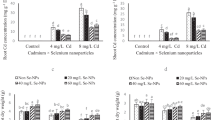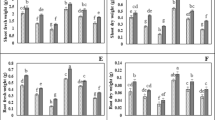Abstract
Cadmium (Cd) is one of the most toxic metals affecting the environment and can severely restrict growth as well as development of animals plus plants in the soil. The aim of this study was to investigate the effect of foliar spraying of iron nanoparticles on antioxidant enzymes plus photosynthetic pigments of purslane (Portulaca oleracea L.) under Cd stress. We applied cadmium chloride at six levels (0, 25, 50, 75, 100 and 125 mg/kg soil) in the soil along with foliar spraying of iron nanoparticles at five levels (0, 0.25, 0.5, 0.75 and 1 g/L). The results indicated that chlorophyll content diminished with increasing Cd stress, while carotenoid content increased with fewer slopes. Foliar spraying of iron nanoparticles at 0.25 and 0.5 g/L improved leaf chlorophyll content in plants grown under 25 and 50 mg/kg of Cd in the soil. The activity of antioxidant enzymes at lower concentrations of Cd and without the foliar spraying of iron nanoparticles was partially enhanced. By increasing the amount of Cd in the soil, the highest activity of guaiacol peroxidase (GP) and ascorbate peroxidase (APX) was recorded when 1 g/L of iron nanoparticles was sprayed. Also, iron nanoparticles at the rate of 0.75 g/L maximized the activity of superoxide dismutase, indicating a positive effect of iron nanoparticles on Cd stress in purslane plants. Based on our results, foliar spraying of iron nanoparticles could enhance the purslane plant tolerance to cadmium through increasing levels of carotenoids and antioxidant enzymes activity.
Zusammenfassung
Cadmium (Cd) ist eines der giftigsten Metalle in der Umwelt und kann das Wachstum und die Entwicklung von Tieren und Pflanzen im Boden stark beeinträchtigen. Ziel dieser Studie war es, die Wirkung des Blattspritzens von Eisennanopartikeln auf antioxidative Enzyme und photosynthetische Pigmente von Portulak (Portulaca oleracea L.) unter Cd-Stress zu untersuchen. Wir brachten Cadmiumchlorid in sechs Konzentrationen (0, 25, 50, 75, 100 und 125 mg/kg Boden) in den Boden ein, während wir gleichzeitig Eisennanopartikel in fünf Konzentrationen (0, 0,25, 0,5, 0,75 und 1 g/L) auf die Blätter sprühten. Die Ergebnisse zeigten, dass der Chlorophyllgehalt mit zunehmender Cd-Belastung abnahm, während der Carotinoidgehalt mit zunahm. Das Besprühen der Blätter mit Eisennanopartikeln in einer Konzentration von 0,25 und 0,5 g/L verbesserte den Chlorophyllgehalt der Blätter bei Pflanzen, die unter 25 und 50 mg/kg Cd im Boden angebaut wurden. Die Aktivität der antioxidativen Enzyme war bei niedrigeren Cd-Konzentrationen und ohne die Blattsprühung von Eisennanopartikeln teilweise erhöht. Bei Erhöhung der Cd-Menge im Boden wurde die höchste Aktivität der Guajakol-Peroxidase (GP) und der Ascorbat-Peroxidase (APX) festgestellt, wenn 1 g/L Eisennanopartikel gesprüht wurden. Außerdem maximierten Eisennanopartikel in einer Menge von 0,75 g/L die Aktivität der Superoxiddismutase, was auf eine positive Wirkung von Eisennanopartikeln auf Cd-Stress bei Portulakpflanzen hinweist. Basierend auf unseren Ergebnissen könnte das Blattspritzen von Eisennanopartikeln die Toleranz der Portulakpflanze gegenüber Cadmium durch die Erhöhung des Gehalts an Carotinoiden und der Aktivität der antioxidativen Enzyme verbessern.






Similar content being viewed by others
References
Abi H (1984) Catalase in vitro. Method Enzymol 105:121–126. https://doi.org/10.1016/s0076-6879(84)05016-3
Avestan A, Naseri L, Najafzadeh R (2018) Improvement of In vitro Proliferation of Apple (Malus domestica Borkh.) by Enriched Nano Chelated Iron Fertilizer. Int J Hortic Sci Technol 5(1):43–51. https://doi.org/10.22059/ijhst.2018.251673.216
Bakhshandeh E, Soltani A, Zeinali E, Kallate-Arabi M (2012) Prediction of plant height by allometric relationships in field-grown wheat. Cereal Res Commun 40:487–496. https://doi.org/10.1556/CRC.40.2012.3.10
Blokhina O, Virolainen E, Fagerstedt KV (2003) Antioxidants, oxidative damage and oxygen deprivation stress: a review. Ann Bot 91:179–194. https://doi.org/10.1093/aob/mcf118
Bonet B, Corcoll N, Tlili A, Morin S, Guasch H (2014) Antioxidant enzyme activities in biofilms as biomarker of Zn pollution in a natural system: an active bio-monitoring study. Ecotoxicol Environ Saf. https://doi.org/10.1016/j.ecoenv.2013.11.007
Bradford MM (1976) A rapid and sensitive method for the quantitative titration of microgram quantities of protein utilizing the principle of protein-dye binding. Anal Biochem. https://doi.org/10.1006/abio.1976.9999
Cai XF, Xu CX, Wang XL, Ge CH (2015) the oxalic acid in plants: Biosynthesis, degradation and its accumulation regulation. Plant Physiol 51(3):267–272. https://doi.org/10.3390/molecules23061286
Chen HD, Yada RN (2011) Nanotechnologies in agriculture: new tools for sustainable development. Trends Food Sci Technol 22:585–594. https://doi.org/10.1016/j.tifs.2011.09.004
Chugh LK, Sawhney SK (1999) Effect of cadmium on activities of some enzymes of glycolysis and pentose phosphate pathway in pea. Biol Plant 42:401–407. https://doi.org/10.1023/A:1002417319599
Daş ZA, Dimlioglu G, Bor M, Ozdemir F (2016) Zinc induced activation of GABA shunt in tobacco (Nicotiana tabaccum L.). Environ Exp Bot 122:78–84. https://doi.org/10.1016/j.jplph.2015.08.005
Dhoke SK, Mahajan P, Kamble R, Khanna A (2013) Effect of nanoparticles suspension on the growth of mung (Vigna radiate L.) seedlings by foliar spray method. Nanotech Dev 3:1–5. https://doi.org/10.4081/nd.2013.e1
Dickinson M, Scott TB (2010) the application of zero-valent iron nanoparticles for the remediation of a Uranium-contaminated waste effluent. J Hazard Mater 178:171–179. https://doi.org/10.1016/j.jhazmat.2010.01.060
Dkhil M, Moniem AA, Al-Quraishy S, Saleh RA (2011) Antioxidant effect of purslane (Portulaca oleracea L.) and its mechanism of action. J Med Plants Res 5(90):1589–1563. https://doi.org/10.1155/2014/951019
Erdei S, Hegedus A, Hauptmann G, Szalai J, Horvath G (2017) Heavy metal induced physiological changes in the antioxidative response system. https://www2.sci.uszeged.hu/ABS/2002/Acta%20HPb/s2/erde.pdf. Accessed 9 May 2017
Farooq MA, Ali S, Hameed A, Bharwana SA, Rizwan M, Ishaque W, Farid M, Mahmood K, Iqbal Z (2016) Cadmium stress in cotton seedlings: physiological, photosynthesis and oxidative damages alleviated by glycinebetaine. S Afr J Bot 104:61–68. https://doi.org/10.1016/j.sajb.2015.11.006
Gill SS, Khan NA, Tuteja N (2012) Cadmium at high dose perturbs growth, photosynthesis and nitrogen metabolism while at low dose it up regulates sulfur assimilation and antioxidant machinery in garden cress (Lepidium sativum L.). Plant Sci 182:112–120. https://doi.org/10.1016/j.plantsci.2011.04.018
Gzyl J, Rymer K, Gwozdz EA (2009) Differential response of antioxidant enzymes to cadmium stress in tolerant and sensitive cell line of cucumber (Cucumis sativus L.). Acta Biochim Pol 56:723–727. https://doi.org/10.18388/abp.2009_2508
Habiba U, Ali S, Farid M, Shakoor MB, Rizwan M, Ibrahim M, Abbasi GH, Hayat T, Ali B (2015) EDTA enhanced plant growth, antioxidant defense system, and phytoextraction of copper by Brassica napus L. Environ Sci Pollut Res Int 22:1534–1544. https://doi.org/10.1007/s11356-014-3431-5
Hsu YT, Kao CH (2007) Toxicity in leaves of rice exposed to cadmium is due to hydrogen peroxide accumulation. Plant Soil 298:231–241. https://doi.org/10.1007/s11104-007-9357-7
Huang S, Wang L, Liu L, Hou Y, Li L (2014) Nanotechnology in agriculture, livestock, and aquaculture in china. A review. Agron Sustain Dev 35:369–400. https://doi.org/10.1007/s13593-014-0274-x
John RP, Ahmad P, Gadgil K, Sharma S (2008) Effect of cadmium and lead on growth, biochemical parametersand uptake in Lemna polyrrhiza L. Plant Soil Environ 54(6):262–270
Konate A, He X, Zhang Z, Ma Y, Zhang P (2017) Magnetic (Fe3O4) nanoparticles reduce heavy metals uptake and mitigate their toxicity in wheat seedling. Sustainability 9(79):1–16. https://doi.org/10.3390/su9050790
Kumar RG, Dubey RS (1999) Glutamine synthetase Isoforms from rice seedlings: effects of stress on enzyme activity and the protective roles of osmolytes. J Plant Physiol 155:118–121. https://doi.org/10.1016/S0176-1617(99)80150-3
Lee SM, Leustek T (1999) The effect of cadmium on sulphate assimilation enzymes in brassica juncea. Plant Sci 141:201–207. https://doi.org/10.1016/S0168-9452(98)00231-3
Lin L, Zhou W, Dai H, Cao F, Zhang G, Wu F (2012) Selenium reduces cadmium uptake and mitigates cadmium toxicity in rice. J Hazard Mater 235:343–351. https://doi.org/10.1016/j.jhazmat.2012.08.012
Liu DL, Hu KQ, Ma JJ, Qiu WW, Wang XP, Zhang SP (2011) Effects of cadmium on the growth and physiological characteristics of sorghum plants. Afr J Biotechnol 10:15770–15776. https://doi.org/10.5897/AJB11.848
Nada E, Ferjani BA, Rhouma A, Bechir BR, Imed M, Makki B (2007) Cadmium-induced growth inhibition and alteration of biochemical parameters in almond seedlings grown in solution culture. Acta Physiol Plant 29:57–62. https://doi.org/10.1007/s11738-006-0009-y
Padmaja K, Prasad DDK, Prasad ARK (1990) Inhibition of chlorophyll synthesis in Phaseolus vulgaris L. seedlings by cadmium acetate. Photosynthetic 24:399–405
Petropoulos S, Karkanis A, Martins N, Ferreira I (2016) Phytochemical composition and bioactive compounds of common purslane (Portulaca oleracea L.) as affected by crop management practices. Trends Food Sci Technol 55:1–10. https://doi.org/10.1016/j.tifs.2016.06.010
Porra RJ (2002) The chequered history of the development and use of simultaneous equations for the accurate determination of chlorophylls a and b. Photosynth Res 73:149–156. https://doi.org/10.1023/A:1020470224740
Qian H, Li J, Sun L, Chen W, Sheng GD, Liu W (2009) Combined effect of copper and cadmium on Chlorella vulgaris growth and photosynthesis-related gene transcription. Aquat Toxicol 94:56–61. https://doi.org/10.1016/j.aquatox.2009.05.014
Qureshi MI, DAmici GM, Fagioni M, Rinalducci S, Zolla L (2010) Iron stabilizes thylakoid protein-pigment complexes in Indian mustard during cd-phytoremediation as revealed by BN-SDS-PAGE and ESI-MS/MS. J Plant Physiol 167(10):761–770. https://doi.org/10.1016/j.jplph.2010.01.017
Savasari M, Emadi M, Bahmanyar MA, Biparva P (2015) Optimization of Cd (II) removal from aqueous solution by ascorbic acid-stabilized zero valent iron nanoparticles using response surface methodology. J Ind Eng Chem 21:1403–1409. https://doi.org/10.1016/j.jiec.2014.06.014
Shen Y, Tang J, Nie Z, Wang Y, Ren Y, Zuo L (2009) Preparation and application of magnetic Fe3O4 nanoparticles for wastewater purification. Sep Purif Technol 68:312–319. https://doi.org/10.1016/j.seppur.2009.05.020
Tang W, Newton JR (2005) Peroxidase and catalase activities are involved in direct adventitious shoot formation induced by thidiazuron in eastern white pine (Pinus scorba L.) zygotic embryos. Plant Physiol Biochem 43:760–769. https://doi.org/10.1016/j.plaphy.2005.05.008
Thanh LB, Quang TD, Yi CC, Cao DN, Kumar MP (2015) Review and human health risk assessment of heavy metals accumulation in vegetables grown in Vinh Quynh, Vietnam. Int J Earth Sci Eng 8(2):723–730. https://doi.org/10.1016/j.tifs.2016.06.010
Torabian S, Zahedi M, Khoshgoftar AH (2017) Effects of foliar spray of nano-particles of FeSO4 on the growth and ion content of sunflower under saline condition. J Plant Nutr 40(5):615–623. https://doi.org/10.1080/01904167.2016.1240187
Wagner GJ (1993) Accumulation of cadmium in crop plants and its consequences to human health. Adv Agric 51:173–212
Wang M, Chen L, Chen S, Ma Y (2012) Alleviation of cadmium-induced root growth inhibition in crop seedlings by nanoparticles. Ecotoxicol Environ Saf 79:48–54. https://doi.org/10.1016/j.ecoenv.2011.11.044
Xue ZC, Gao HY, Zhang LT (2013) Effects of cadmium on growth, photosynthetic rate, and chlorophyll content in leaves of soybean seedlings. Biol Plant 57:587–590. https://doi.org/10.1007/s10535-013-0318-0
Yaghoubian Y, Siadat SA, Moradi Telavata MR, Pirdashti H (2016) Quantify the response of purslane plant growth, photosynthesis pigments and photosystem II photochemistry to cadmium concentration gradients in the soil. Russ J Plant Physiol 63(1):77–84. https://doi.org/10.1134/S1021443716010180
Yoshimura K, Yabuta Y, Ishikawa T, Shigeoka S (2000) Expression of spinach ascorbate peroxidase isoenzymes in response to oxidative stresses. Plant Physiol 123:223–234. https://doi.org/10.1104/pp.123.1.223
Zhang FQ, Wang YS, Lou ZP, Dong JD (2007) Effect of heavy metal stress on antioxidative enzymes and lipid peroxidation in leaves and roots of two mangrove plant seedlings (Kandelia candel and Bruguiera gymnorrhiza). Chemosphere 67:44–50. https://doi.org/10.1104/pp.123.1.223
Zhang M, He F, Zhao D, Hao X (2011) Degradation of soil sorbed trichloroethylene by stabilized zero valent iron nanoparticles: effects of sorption, surfactants, and natural organic matter. Water Res 45:2401–2414. https://doi.org/10.1016/j.watres.2011.01.028
Zhu GX, Guo QJ, Xiao HY, Chen TB, Yang J (2017) Multivariate statistical and lead isotopic analyses approach to identify heavy metal sources in topsoil from the industrial zone of Beijing capital iron and steel factory. Environ Sci Pollut Res 24:14877–14888. https://doi.org/10.1007/s11356-017-9055-9
Zuo Y, Zhang FS (2011) Soil and crop management strategies to prevent iron deficiency in crops. Plant Soil 339:83–95. https://doi.org/10.1007/s11104-010-0566-0
Acknowledgements
The authors wish to acknowledge Shahrood University of Technology (Shahrood, Iran), Genetics and Agricultural Biotechnology Institute of Tabarestan (GABIT), and Sari Agricultural Sciences and Natural Resources University (Sari, Iran) for financial support of this study.
Author information
Authors and Affiliations
Corresponding author
Ethics declarations
Conflict of interest
Z.N. Akandi, H. Makarian, H. Pirdashti, M.R. Amerian, M. Baradaran Firozabadi and M.A. Tajik Ghanbary declare that they have no competing interests.
Rights and permissions
About this article
Cite this article
Akandi, Z.N., Makarian, H., Pirdashti, H. et al. Iron Nanoparticles-induced Improvement of Antioxidant Enzymes and Photosynthetic Pigments of Purslane (Portulaca oleracea L.) Under Cadmium Stress. Gesunde Pflanzen 74, 829–838 (2022). https://doi.org/10.1007/s10343-022-00680-9
Received:
Accepted:
Published:
Issue Date:
DOI: https://doi.org/10.1007/s10343-022-00680-9




